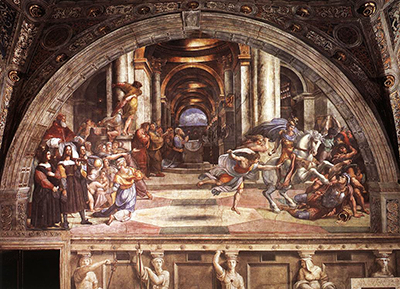 Buy Art Prints Now
Buy Art Prints Nowfrom Amazon
* As an Amazon Associate, and partner with Google Adsense and Ezoic, I earn from qualifying purchases.
Raphael was commissioned by Pope Julius II to work on his private apartments at the Vatican, now known as the Raphael Rooms. Young and relatively unknown in Rome, Raphael worked on four rooms simply known as the Stanze.
Between 1511 and 1514 Raphael worked on the Stanza di Eliodoro, or Room of Heliodorus, the name taken from one of his paintings within the room, The Expulsion of Heliodorus from the Temple. In the painting Heliodorus, who has been sent to the Temple of Jerusalem by the Syrian King to seize its treasures, is chased out of the temple by a heavenly horseman.
The Expulsion of Heliodorus from the Temple is a fresco 750cm in width based on a story in Maccabees 2, and is striking in its symbolism and composition. Heliodorus is depicted on the ground in the lower right section of the fresco. Looming above him are the horseman and two angels who answer the prayers of the priest to come and protect the Temple. On the left of the painting, carried in a chair by two guards, is the depiction of Pope Julius II, who had been waging a battle to stop secular rulers from taking over papal territories. The message was simple. This belongs to the church, keep your hands off. Some also believe Raphael has included himself in the painting, standing next to the Pope’s chair bearers. He watches on as the angels whip Heliodorus, the whips symbolising the artist’s brush as he battles with the anguish of trying to create.
The composition of the Expulsion of Heliodorus from the Temple is noteworthy too as it is different from his earlier work. In this painting Raphael breaks up the focal points of the images, placing them to the sides, creating space through the middle. It is a marked move away from the controlled, symmetrical approach to the Stanza della Segnatura, the first of the rooms he painted. It allows for the nave to be lit by light, with one of the angel's shadows casting an almost perfect circle in one of the flooring stones. This more dynamic imagery continues in to his subsequent frescoes.
Raphael's work on the papal rooms was started soon after Michaelangelo had completed the ceiling frescoes in the Sistine Chapel. It would be hard to imagine Raphael not having looked at the Sistine Chapel prior to beginning his own work for some inspiration. It is also said Raphael served an apprenticeship under Pietro Perugino who influenced his early work, and Perugino worked with Michaelangelo in the Sistine Chapel. However from his time in Florence which overlapped a period when Leonardo da Vinci was in the Italian city, his compositions and dramatic figures were probably influenced by this particular master.
Acknowledged as the architect of High Renaissance, Raphael has influenced and inspired artists and admirers through the years, including Titian who was only a few years younger then Raphael. Thirty years of restoration work has recently been completed in the Raphael rooms in the Vatican, where visitors can see the frescos, including The Expulsion of Heliodorus from the Temple in all their wonderful glory.




